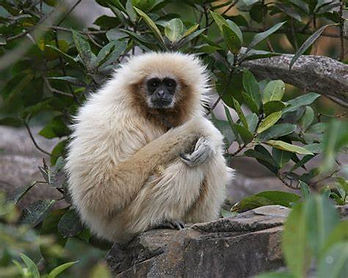Lar Gibbon
They are also known as the White-Handed gibbon. They are an endangered primate from the Gibbon Family. There are five subspecies of Lar Gibbon, Malaysian Lar Gibbon, Carpenter's Lar Gibbon, Central Lar Gibbon, Sumatran Lar Gibbon, Yunnan Lar Gibbon. It is one of the better known gibbons and is often kept in captivity. The fur colouring of the lar gibbon varies from black and dark brown to light-brown, sandy colours.

Habitat
They have the greatest north-south range of any of the gibbon species. They are found in Indonesia, Laos, Malaysia, Myanmar and Thailand. Their range historically extended from southwest China to Thailand and Burma south to the whole Malay Peninsula in primary and secondary tropical rain forests. They are also present in the northwest portion of the island of Sumatra. They are likely to be extinct in China, but if they still exist, they would only be found in southwest Yunnan, their former range. They are usually found in lowland dipterocarp forests, hill dipterocarp forest, and upper dipterocarp forest, including primary lowland and submontane forest , mixed deciduous forest, and seasonal evergreen forests. The map to the right shows other species as well but the one we are focusing on is the orange colour for the Lar Gibbon.

Diet
They are considered frugivores with fruit constituting 50% of its diet, but leaves(29%) are a substantial part, with insects(13%) and flowers(9%) forming the remainder. In the wild, they will eat a large variety of foods, including figs and other small, sweet fruits, liana fruit, tree fruits and berries, as well as young leaves, buds and flowers, vines, vine shoots and insects, including mantids and wasps, and even birds eggs. During the summer months when figs and leaves are less available, insect consumption increases twenty fold relative to winter.
Breeding
Sexually, they are similar to other gibbons. Mating occurs in every month of the year, but most conceptions occur during the dry season in March, with a peak in births during the late rainy season, in October. On average, females reproduce for the first time at about 11 years of age in the wild, much later than in captivity. Gestation is six months long on average, and pregnancies are usually of a single young. Young are nursed for approximately two years, and full maturity comes at about eight years. The life expectancy of the lar gibbons in the wild is about 25 years.
Population
They are currently classed as endangered on the IUCN Red List. No population estimates are currently available for Indonesia, Malaysia, and Myanmar. While for Lao PDR, there are no reliable estimates, but for Nam Poyi National Protected Area (which is the only protected area from which they are recorded), the species is uncommon to rare, perhaps numbering in the mid- to high-hundreds. In some parts of Thailand there are several populations where numbers are at least in the thousands, though in northern Thailand they are now very rare. The largest population is in Kaeng Krachan National Park, which probably has on the order of 3,000-4,000 individuals.
Threats
The major threat to this species is hunting (having replaced even forest clearance as the top threat); they are hunted both for subsistence food use and for the pet trade. Hunting pressure varies across the range, but takes place even within protected areas. Much of the hunting is done by villagers exploiting Aquilaria spp. trees prized for their aromatic wood, and other forest products.
Construction of roads through protected areas may also pose a threat since it promotes forest clearance and strip development, possibly increases fragmentation, and increases access by hunters into protected areas. Ongoing localized forest loss due to shifting agriculture and commercial plantations of palm oil poses a threat. On northern Sumatra, most of the lowland forests have been logged out and the threat of Ladia Galaskar, a network to link the west and east coasts of Aceh province, means that much of the remaining forest is at risk.
Conservation
Like all gibbons, is a nationally protected species in all the countries across its range, and is listed under CITES Appendix I. In most of its range it is confined to protected conservation areas (for example in Thailand, where no significant populations survive outside of protected areas). However, in most countries, these areas are not well patrolled, even if they are well managed for tourism. There is an urgent need for improved protection of these areas, ideally involving local communities that should benefit from as well as participate in management. Illegal use of forest products, as well as poaching, is common in most protected areas. Inadequate management and protection, rather than forest destruction, are the main long-term threats and conservation efforts must seek to identify the hunters and incorporate them into new management priorities. Further survey work is needed to determine current population numbers within protected areas across the range. One such priority area is southwest Yunnan, where it is unclear whether the species still survives..